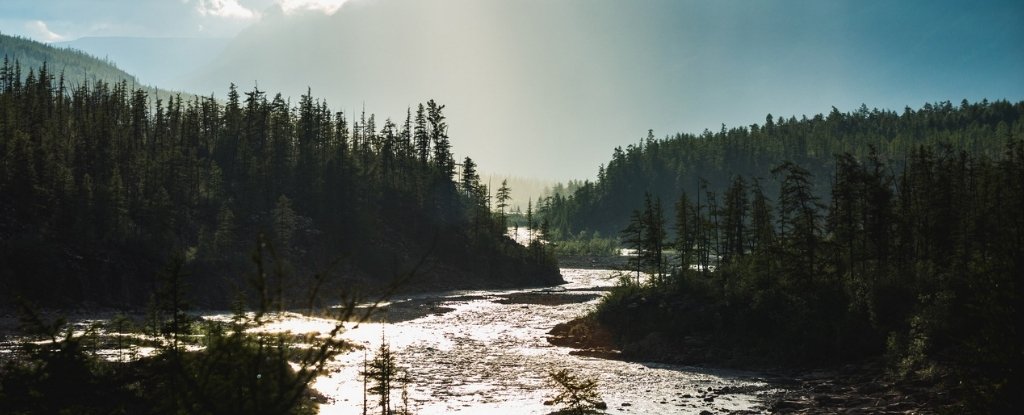
(Ukususha/Getty Images)
CARLY CASSELLA
30 SEPTEMBER 2020
Rampant air pollution in northern Siberia is blocking sunlight and slowing the growth of boreal forests, new research suggests
The largest study of tree rings in Norilsk, Russia's most polluted city and the northernmost city in the world, has found air pollution from local mines and smelters are at least partly to blame for a phenomenon known as 'Arctic dimming'.
Similar to 'global dimming', this more regional effect occurs when tiny particulates – from air pollution, volcanic eruptions, and dust – gather in the atmosphere, where they partially absorb or scatter solar energy, messing with light availability, evaporation, and hydrology on the ground.
Long-term observations and satellite measurements have shown the amount of solar radiation reaching the Arctic's surface has decreased since the mid-century, but it wasn't clear if that was due to human pollution in the region.
Today, after nearly a century of heavy, unregulated mining, tree die-off near Norilsk has spread up to 100 kilometres, but this is one of the first studies to connect that shrinking forest with reduced sunlight.
"While the problem of sulphur emissions and forest dieback has been successfully addressed in much of Europe, for Siberia, we haven't been able to see what the impact has been, largely due to a lack of long-term monitoring data," says environmental systems analyst Ulf Büntgen from Cambridge University.
And yet, this region is one of the most heavily polluted in the world. So, by reading thousands of tree rings from living and dead conifers surrounding the city of Norilsk, researchers sought to reconstruct what happened to this once pristine forest.
Using wood and soil chemistry, they mapped the extent of Norilsk's uncontrolled environmental devastation over the course of nine decades.
"We can see that the trees near Norilsk started to die off massively in the 1960s due to rising pollution levels," says Büntgen.
Using solar radiation reaching the surface as a proxy for air pollution up in the atmosphere, the team's models provide "strong evidence" that Arctic dimming has substantially reduced tree growth since the '70s.
Today, the authors say, boreal forests in Eurasia and northern North America also have largely become a "dumping ground for large concentrations of anthropogenic air pollutants", and so the effects of Arctic dimming might be felt much more broadly outside the Norilsk region studied here.
Unfortunately, because of large-scale circulation patterns, we know that pollutants tend to accumulate in the Arctic atmosphere, and this means ecosystems up north may be especially vulnerable to global pollution as a whole.
Even knowing this, the authors were not prepared for the extent of the problem they uncovered.
"What surprised us is just how widespread the effects of industrial pollution are - the scale of the damage shows just how vulnerable and sensitive the boreal forest is," says Büntgen.
"Given the ecological importance of this biome, the pollution levels across the high-northern latitudes could have an enormous impact on the entire global carbon cycle."
Nor is pollution the only threat to these precious ecosystems, sometimes described as 'lungs' for our planet. Climate change looks as though it's also altering the diversity of boreal forests, while more intense and frequent wildfires are wiping out huge swathes of Siberia on an annual basis, contributing to further regional air pollution.
While some global warming models suggest tree growth will increase with climate change, the new research highlights that air pollution may outweigh this, meaning trees in the Arctic north will grow slower and weaker than before.
Further research should look at how air pollution could lead to reduced solar radiation, either through absorbing solar radiation directly or indirectly through its effects on clouds.
Given how important these boreal forests are as a carbon sink and how vulnerable they appear to be, the authors are calling for further insight into the long‐term effects of industrial emissions on the world's northernmost forests.
"This study appears particularly timely in the light of Norilsk's unprecedented release of more than 20,000 tons [of] diesel oil in 2020," they write, "an environmental disaster that emphasises the threat of Norilsk's industrial sector under rapid Arctic warming and permafrost thawing, and also stresses the ecological vulnerability of the high‐northern latitudes."
The study was published in Ecology Letters.
No comments:
Post a Comment